Spatiotemporal Patterns and Evolution of Storm Surge Threats along the Southeastern Coastline of China
Abstract
1. Introduction
2. Data and Methodology
2.1. Tide-Gauge Data and TC Best Tracks Dataset
2.2. Metric of Storm Surge Potential Impact
2.2.1. Anomaly Nontidal Impact Level
2.2.2. Accumulated Storm Surge Potential Impact (ASPI)
3. Results
3.1. Variability of Storm Surge Potential Impact
3.2. Spatial Distribution of Storm Surge Potential Impact
3.3. The Evolution of Spatial Distribution
4. Conclusion and Discussion
Author Contributions
Funding
Acknowledgments
Conflicts of Interest
References
- State Oceanic Administration of China. Marine Disaster Bulletin. 1989–2017. Available online: http://www.coi.gov.cn/gongbao/zaihai/ (accessed on 18 July 2018).
- Hallegatte, S.; Green, C.; Nicholls, R.J.; Corfee-Morlot, J. Future flood losses in major coastal cities. Nat. Clim. Chang. 2013, 3, 802–806. [Google Scholar] [CrossRef]
- Dasgupta, S.; Laplante, B.; Murray, S.; Wheeler, D. Climate Change and the Future Impacts of Storm-Surge Disasters in Developing Countries; Policy Research Working Paper; Center for Global Development 182, The World Bank Development Research Group Environment and Energy Team: Washington, DC, USA, 2009. [Google Scholar]
- Walsh, K.J.E.; McBride, J.L.; Klotzbach, P.J.; Balachandran, S.; Camargo, S.J.; Holland, G.; Knutson, T.R.; Kossin, J.P.; Lee, T.C.; Sobel, A.; et al. Tropical cyclones and climate change. WIREs Clim. Chang. 2016, 7, 65–89. [Google Scholar] [CrossRef]
- Bromirski, P.D.; Flick, R.E.; Miller, A.J. Storm surge along the Pacific coast of North America. J. Geophys. Res. Oceans 2017, 122, 441–457. [Google Scholar] [CrossRef]
- Marsooli, R.; Lin, N. Numerical Modeling of Historical Storm Tides and Waves and Their Interactions Along the US East and Gulf Coasts. J. Geophys. Res. Oceans 2018, 123, 3844–3874. [Google Scholar] [CrossRef]
- Menendez, M.; Woodworth, P.L. Changes in extreme high water levels based on a quasi-global tide-gauge data set. J. Geophys. Res. Oceans 2010, 115. [Google Scholar] [CrossRef]
- De Vries, H.; Breton, M.; de Mulder, T.; Krestenitis, Y.; Ozer, J.; Proctor, R.; Ruddick, K.; Salomon, J.C.; Voorrips, A. A comparison of 2D storm surge models applied to three shallow European seas. Environ. Softw. 1995, 10, 23–42. [Google Scholar] [CrossRef]
- Williams, J.; Horsburgh, K.J.; Williams, J.A.; Proctor, R.N.F. Tide and skew surge independence: New insights for flood risk. Geophys. Res. Lett. 2016, 43, 6410–6417. [Google Scholar] [CrossRef]
- Grinsted, A.; Moore, J.C.; Jevrejeva, S. Homogeneous record of Atlantic hurricane surge threat since 1923. Proc. Natl. Acad. Sci. USA 2012, 109, 19601–19605. [Google Scholar] [CrossRef]
- Marcos, M.; Calafat, F.M.; Berihuete, A.; Dangendorf, S. Long-term variations in global sea level extremes. J. Geophys. Res. Oceans 2015, 120, 8115–8134. [Google Scholar] [CrossRef]
- Marcos, M.; Woodworth, P.L. Spatiotemporal changes in extreme sea levels along the coasts of the North Atlantic and the Gulf of Mexico. J. Geophys. Res. Oceans 2017, 122, 7031–7048. [Google Scholar] [CrossRef]
- Haigh, I.; Nicholls, R.; Wells, N. Assessing changes in extreme sea levels: Application to the English Channel, 1900-2006. Cont. Shelf Res. 2010, 30, 1042–1055. [Google Scholar] [CrossRef]
- Pugh, D.T. Estimating Extreme Currents by Combining Tidal and Surge Probabilities. Ocean Eng. 1982, 9, 361–372. [Google Scholar] [CrossRef]
- Bilskie, M.V.; Hagen, S.C.; Medeiros, S.C.; Cox, A.T.; Salisbury, M.; Coggin, D. Data and numerical analysis of astronomic tides, wind-waves, and hurricane storm surge along the northern Gulf of Mexico. J. Geophys. Res. Oceans 2016, 121, 3625–3658. [Google Scholar] [CrossRef]
- Wu, W.Y.; Westra, S.; Leonard, M. A basis function approach for exploring the seasonal and spatial features of storm surge events. Geophys. Res. Lett. 2017, 44, 7356–7365. [Google Scholar] [CrossRef]
- Needham, H.F.; Keim, B.D.; Sathiaraj, D. A review of tropical cyclone-generated storm surges: Global data sources, observations, and impacts. Rev. Geophys. 2015, 53, 545–591. [Google Scholar] [CrossRef]
- Feng, J.L.; Li, D.L.; Wang, H.; Liu, Q.L.; Zhang, J.L.; Li, Y.; Liu, K.X. Analysis on the Extreme Sea Levels Changes along the Coastline of Bohai Sea, China. Atmosphere 2018, 9, 324. [Google Scholar] [CrossRef]
- Maskey, S. Flood risk in the changing climate. J. Flood Risk Manag. 2018, 11, 109–110. [Google Scholar] [CrossRef]
- Feng, J.L.; von Storch, H.; Jiang, W.S.; Weisse, R. Assessing changes in extreme sea levels along the coast of China. J. Geophys. Res. Oceans 2015, 120, 8039–8051. [Google Scholar] [CrossRef]
- Feng, X.B.; Tsimplis, M.N. Sea level extremes at the coasts of China. J. Geophys. Res. Oceans 2014, 119, 1593–1608. [Google Scholar] [CrossRef]
- Oey, L.Y.; Chou, S. Evidence of rising and poleward shift of storm surge in western North Pacific in recent decades. J. Geophys. Res. Oceans 2016, 121, 5181–5192. [Google Scholar] [CrossRef]
- Knapp, K.R.; Kruk, M.C.; Levinson, D.H.; Diamond, H.J.; Neumann, C.J. The International Best Track Archive For Climate Stewardship(IBTrACS) Unifying Tropical Cyclone Data. Bull. Am. Meteorol. Soc. 2010, 91, 363–376. [Google Scholar] [CrossRef]
- Kossin, J.P.; Emanuel, K.A.; Vecchi, G.A. The poleward migration of the location of tropical cyclone maximum intensity. Nature 2014, 509, 349–352. [Google Scholar] [CrossRef] [PubMed]
- Kossin, J.P. Hurricane intensification along United States coast suppressed during active hurricane periods. Nature 2017, 541, 390–393. [Google Scholar] [CrossRef] [PubMed]
- Kossin, J.P. A global slowdown of tropical-cyclone translation speed. Nature 2018, 558, 104–107. [Google Scholar] [CrossRef] [PubMed]
- Romero, R.; Emanuel, K. Climate Change and Hurricane-Like Extratropical Cyclones: Projections for North Atlantic Polar Lows and Medicanes Based on CMIP5 Models. J. Clim. 2017, 30, 279–299. [Google Scholar] [CrossRef]
- Gao, Y.; Wang, H.; Liu, G.M.; Sun, X.Y.; Fei, X.Y.; Wang, P.T.; Lv, T.T.; Xue, Z.S.; He, Y.W. Risk assessment of tropical storm surges for coastal regions of China. J. Geophys. Res. Atmos. 2014, 119, 5364–5374. [Google Scholar] [CrossRef]
- Shi, X.W.; Gao, T.; Tan, J.; Guo, Z.X. Research on Occurrence Frequency of Storm Surge Disaster Distribution in the Coastal Areas of China. J. Catastrophol. 2018, 33, 49–52. (In Chinese) [Google Scholar]
- Munroe, R.; Curtis, S. Storm surge evolution and its relationship to climate oscillations at Duck, NC. Theor. Appl. Climatol. 2017, 129, 185–200. [Google Scholar] [CrossRef]
- Department of Hydrology Ministry of Water Resources the People‘s Republic of China. Annual Hydrological Report; The Ministry of Water Resources of China: Beijing, China, 1960–2015; Volumes 5–8.
- Caldwell, P.C.; Merrifield, M.A.; Thompson, P.R. Sea Level Measured by Tide Gauges from Global Oceans—The Joint Archive for Sea Level Holdings (NCEI Accession 0019568), version 5.5; NOAA, National Centers for Environmental Information: Asheville, NC, USA, 2015. [Google Scholar] [CrossRef]
- Yu, F.J.; Dong, J.X. Collection of Storm Surge Disasters Historical Data in China 1949–2009; China Ocean Press: Beijing, China, 2015; Volumes 1–2. [Google Scholar]
- Hou, J.; Yu, F.; Yuan, Y.; Fu, X. Spatial and temporal distribution of red tropical storm surge disasters in China. Mar. Sci. Bull. 2011, 30. [Google Scholar]
- JMA. RSMC Tropical Cyclone Best Track Data. 1951–2017. Available online: http://www.jma.go.jp/jma/jma-eng/jma-center/rsmc-hp-pub-eg/RSMC_HP.htm (accessed on 25 March 2018).
- Pugh, D.; Woodworth, P.L. Sea-Level Science: Understanding Tides, Surges, Tsunamis and Mean Sea-Level Changes; Cambridge University Press: Cambridge, UK, 2014; pp. 400–410. [Google Scholar]
- Zhang, K.Q.; Douglas, B.C.; Leatherman, S.P. Twentieth-century storm activity along the US east coast. J. Clim. 2000, 13, 1748–1761. [Google Scholar] [CrossRef]
- Haigh, I.D.; Nicholls, R.; Wells, N. A comparison of the main methods for estimating probabilities of extreme still water levels. Coast. Eng. 2010, 57, 838–849. [Google Scholar] [CrossRef]
- Cid, A.; Menéndez, M.; Castanedo, S.; Abascal, A.J.; Méndez, F.J.; Medina, R. Long-term changes in the frequency, intensity and duration of extreme storm surge events in southern Europe. Clim. Dyn. 2016, 46, 1503–1516. [Google Scholar] [CrossRef]
- Bell, G.D.; Halpert, M.S.; Schnell, R.C.; Higgins, R.W.; Lawrimore, J.; Kousky, V.E.; Tinker, R.; Thiaw, W.; Chelliah, M.; Artusa, A. Climate assessment for 1999. Bull. Am. Meteorol. Soc. 2000, 81, S1–S50. [Google Scholar] [CrossRef]
- Mei, W.; Xie, S.P. Intensification of landfalling typhoons over the northwest Pacific since the late 1970s. Nat. Geosci. 2016, 9, 753–757. [Google Scholar] [CrossRef]
- WU, L.G.; Wang, B.; Geng, S.Q. Growing typhoon influence on east Asia. Geophys. Res. Lett. 2005, 32. [Google Scholar] [CrossRef]
- Ren, F.M.; Wu, G.X.; Dong, W.J.; Wang, X.L.; Wang, Y.M.; Ai, W.X.; Li, W.J. Changes in tropical cyclone precipitation over China. Geophys. Res. Lett. 2006, 33. [Google Scholar] [CrossRef]
- Knutson, T.R.; McBride, J.L.; Chan, J.; Emanuel, K.; Holland, G.; Landsea, C.; Held, I.; Kossin, J.P.; Srivastava, A.K.; Sugi, M. Tropical cyclones and climate change. Nat. Geosci. 2010, 3, 157–163. [Google Scholar] [CrossRef]
- Lee, B.S.; Haran, M.; Keller, K. Multidecadal Scale Detection Time for Potentially Increasing Atlantic Storm Surges in a Warming Climate. Geophys. Res. Lett. 2017, 44, 10617–10623. [Google Scholar] [CrossRef]
- Vousdoukas, M.I.; Voukouvalas, E.; Annunziato, A.; Giardino, A.; Feyen, L. Projections of extreme storm surge levels along Europe. Clim. Dyn. 2016, 47, 3171–3190. [Google Scholar] [CrossRef]
- Woodworth, P.L.; Menendez, M.; Gehrels, W.R. Evidence for Century-Timescale Acceleration in Mean Sea Levels and for Recent Changes in Extreme Sea Levels. Surv. Geophys. 2011, 32, 603–618. [Google Scholar] [CrossRef]
- Wahl, T.; Chambers, D.P. Evidence for multidecadal variability in US extreme sea level records. J. Geophys. Res. Oceans 2015, 120, 1527–1544. [Google Scholar] [CrossRef]
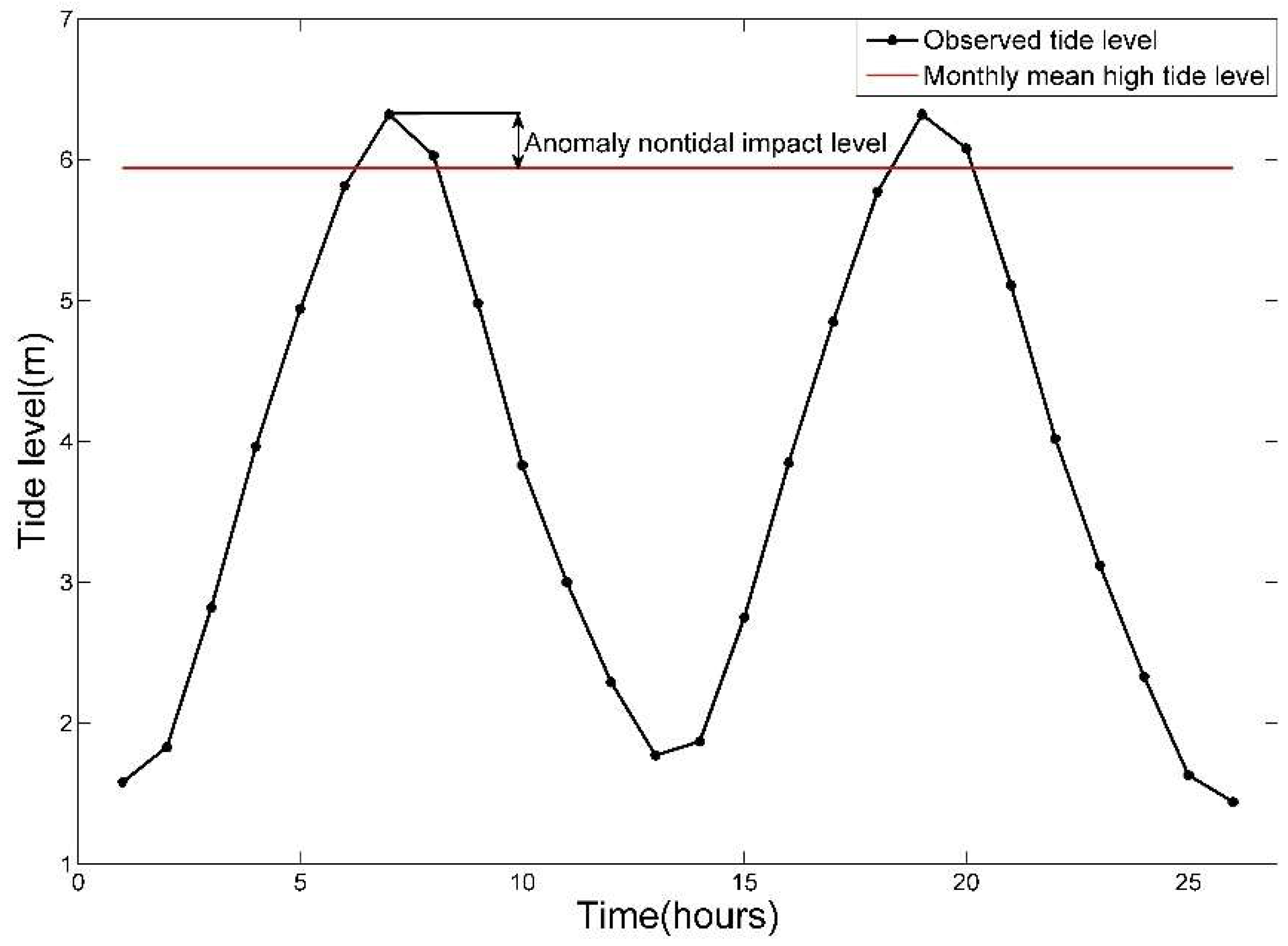

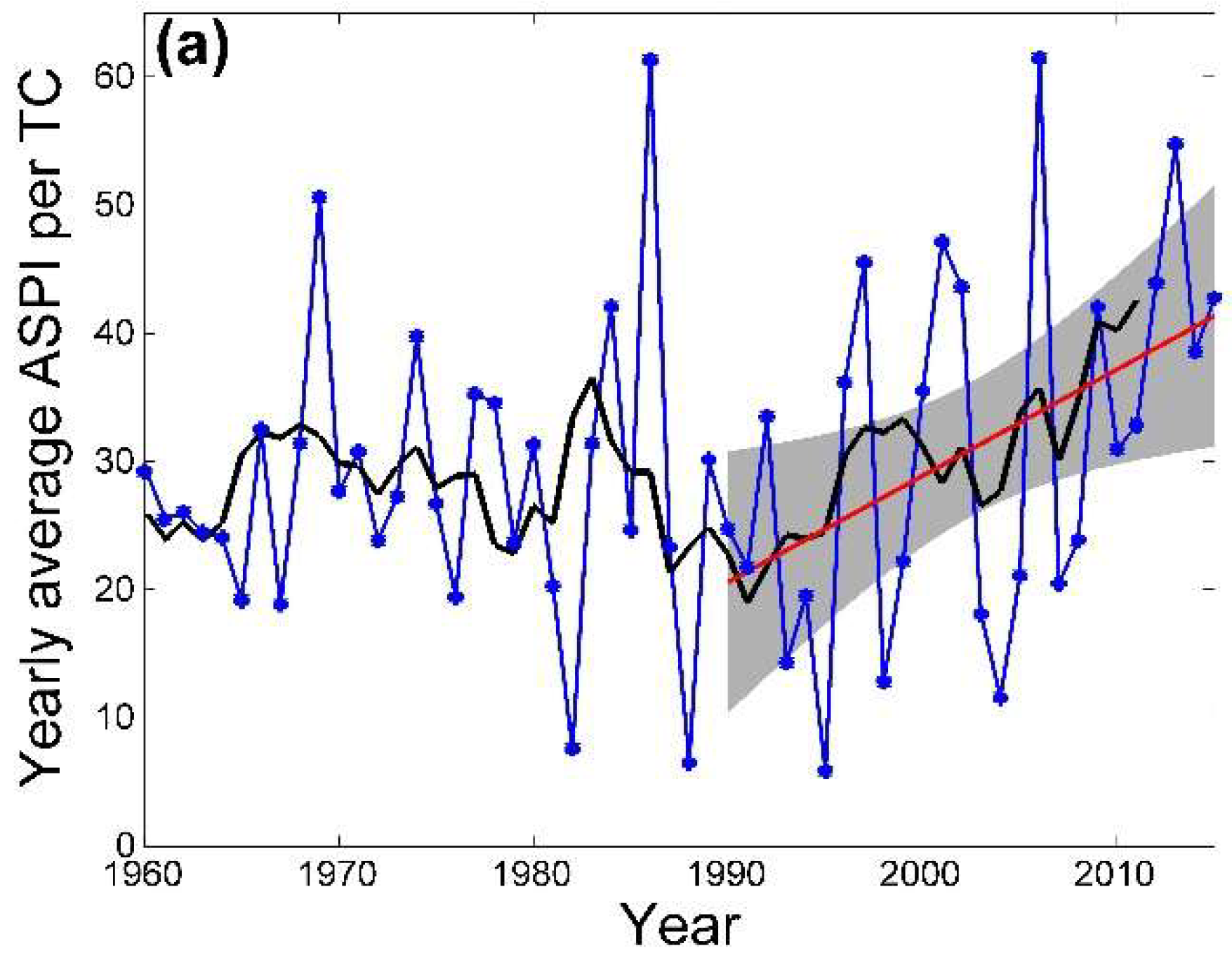
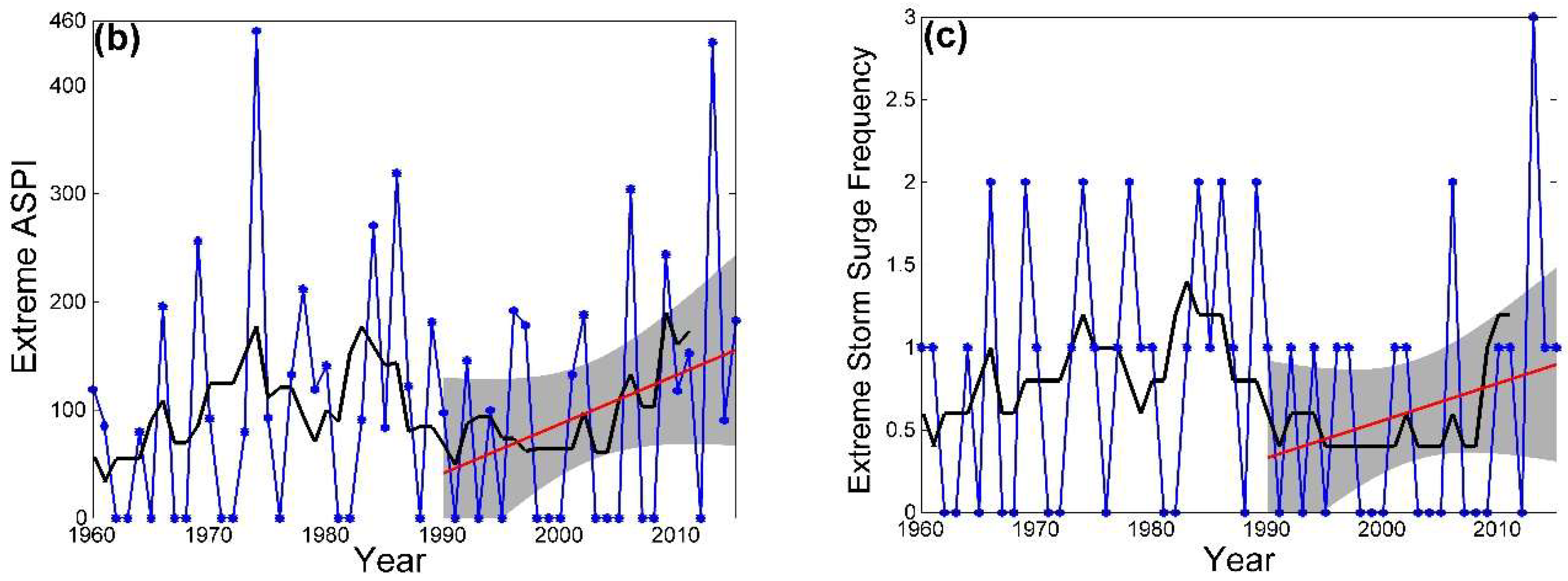



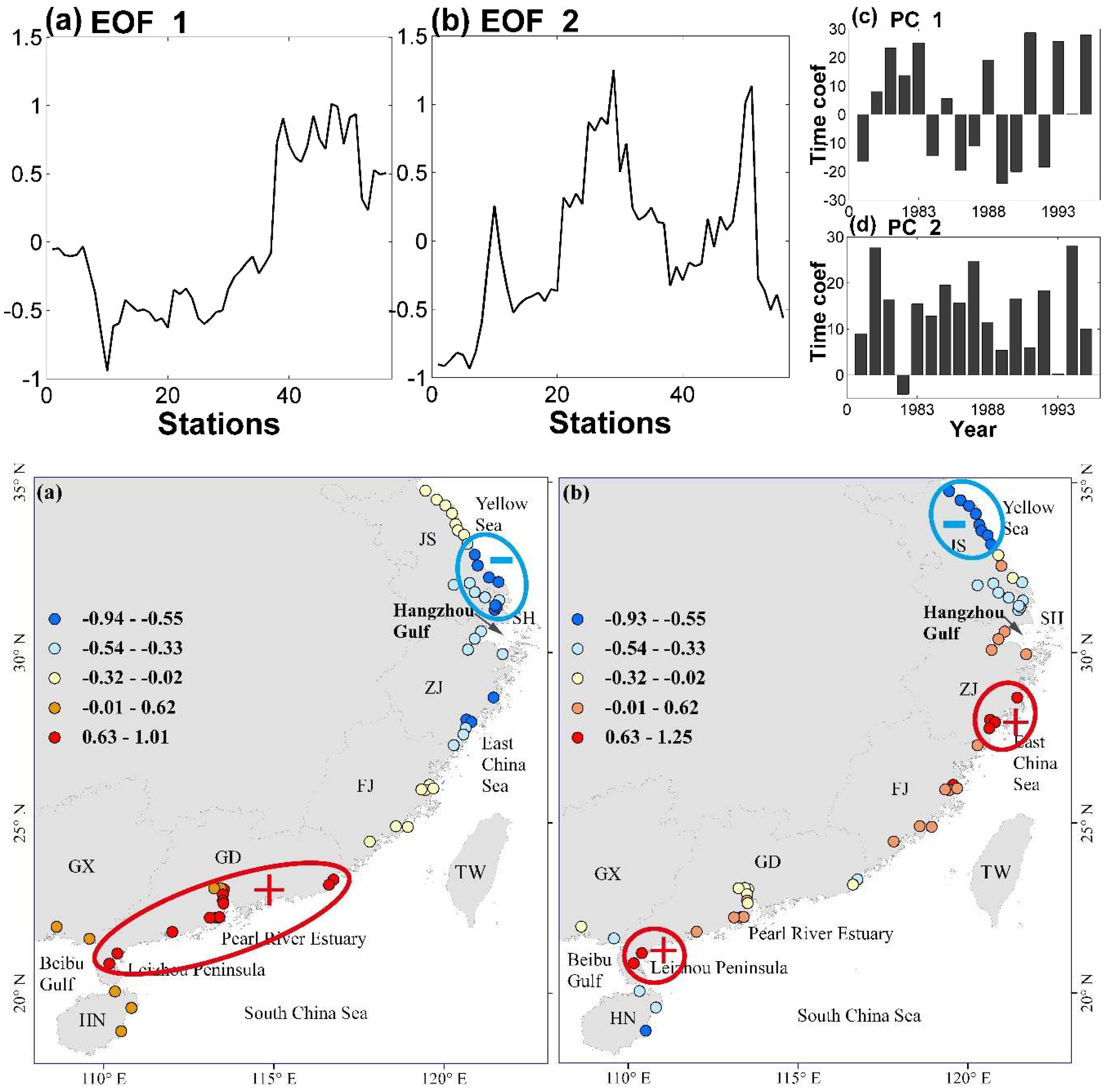

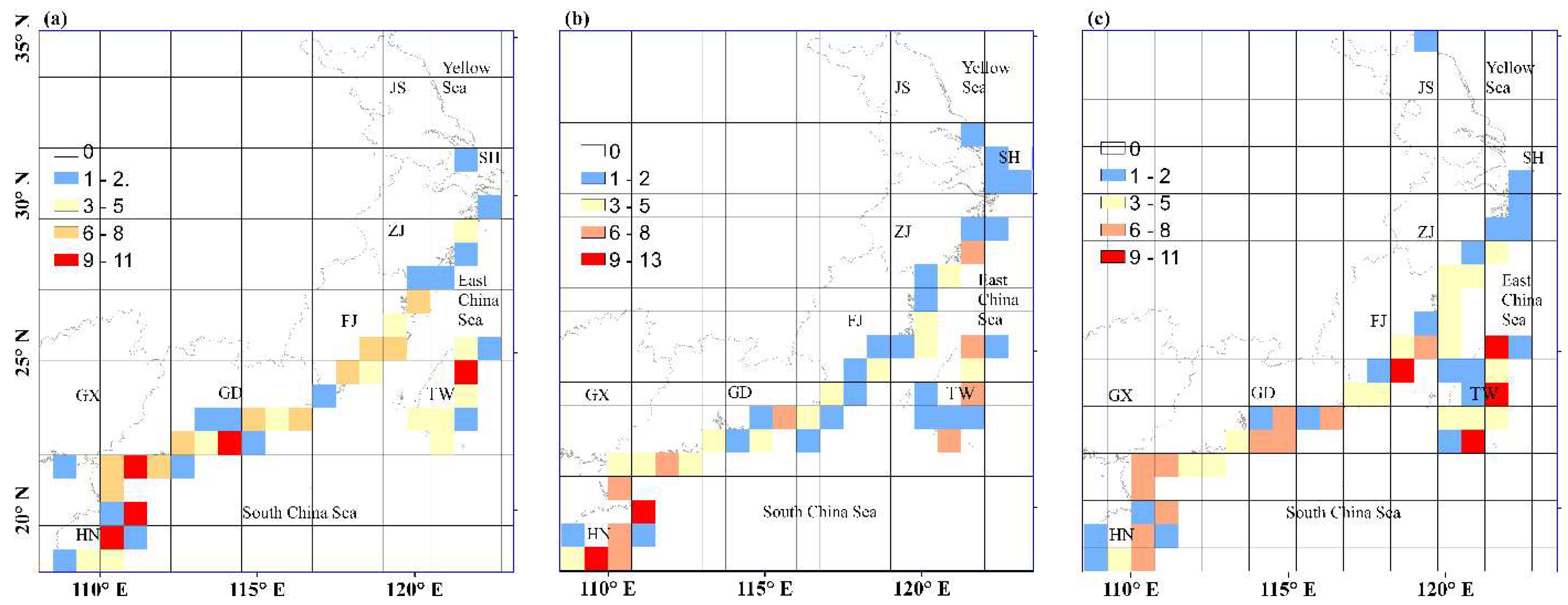
© 2019 by the authors. Licensee MDPI, Basel, Switzerland. This article is an open access article distributed under the terms and conditions of the Creative Commons Attribution (CC BY) license (http://creativecommons.org/licenses/by/4.0/).
Share and Cite
Zhang, Y.; Li, G.; Guo, T. Spatiotemporal Patterns and Evolution of Storm Surge Threats along the Southeastern Coastline of China. Atmosphere 2019, 10, 61. https://doi.org/10.3390/atmos10020061
Zhang Y, Li G, Guo T. Spatiotemporal Patterns and Evolution of Storm Surge Threats along the Southeastern Coastline of China. Atmosphere. 2019; 10(2):61. https://doi.org/10.3390/atmos10020061
Chicago/Turabian StyleZhang, Yue, Guosheng Li, and Tengjiao Guo. 2019. "Spatiotemporal Patterns and Evolution of Storm Surge Threats along the Southeastern Coastline of China" Atmosphere 10, no. 2: 61. https://doi.org/10.3390/atmos10020061
APA StyleZhang, Y., Li, G., & Guo, T. (2019). Spatiotemporal Patterns and Evolution of Storm Surge Threats along the Southeastern Coastline of China. Atmosphere, 10(2), 61. https://doi.org/10.3390/atmos10020061




